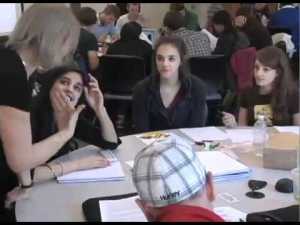Flipping the College Classroom
April 15, 2012 7 Comments
Flipping the College Classroom
For the past century, and probably for centuries before that, the typical classroom learning experience on just about every college campus in the world has remained the same. Oh sure, we’ve got PowerBooks and Power Point and lots of technological gizmos these days, but in most classrooms it’s the same as it ever was. The faculty member – the Sage on the Stage – lectures while the students listen and take notes.
But oh how things have changed. When I first started teaching my biggest problem was keeping an eye on students who were passing notes back and forth. Now, it’s “Teacher vs. Twitter” as I am competing with Facebook, Google+, iPhones, iPads, Angry Birds and more. The distraction factor is not even the worst part; it’s a true fact that just about everything I have to say in a three-hour lecture can be found via a three-second search on every student’s personal favorite electronic gizmo, sitting right there in their hand.
Perhaps it is time for the classroom to change.
Lesson Plans in the Lurch.
To explain how the classroom can change, we first need to understand the learning process. To put it quite simply, there are two parts to the learning process: transmission and assimilation. In a typical college classroom, transmission takes place as a professor lectures and students take notes. Transmission also occurs during reading, although getting the students to actually read the textbook is a challenge unto itself, and one that perhaps I should address at another time.
The second part of learning, assimilation, generally occurs outside a typical classroom as the student does homework, lab work, studies his notes, or takes part in a cooperative learning project.
If we refer back to the Learning Taxonomy of Benjamin Bloom, we can see that “transmission” involves the lower order level thinking skills of knowledge and understanding, while “assimilation” involves the higher order thinking skills of application, analysis, creation (synthesis) and evaluation. In layman’s terms, “real” learning occurs outside the traditional classroom.
The big issue with this traditional model is that as the student’s cognitive load increases, the availability of help, in the form of the professor, decreases. This model is reversed in a flipped classroom, where (to put it very, very simply) transmission occurs before class, and assimilation takes place during class, with the aid and help of the instructor.
Transmission…Before Class
The very technology that is causing widespread student distraction during class in the first place can be put to use in asking students to view a video of a lecture before class. Students can be assigned lectures to view via Youtube, iTunes or other media, and may be required to be involved in online chats or forum discussions. At its most basic, transmission before class can take the form of a good, old-fashioned text book reading assignment.
Obviously, an excellent text book, a series of recorded lectures, and a reliable delivery system are pre-requisites for flipping the classroom. In addition, guided practice for basic knowledge and skills such as take-home or online quizzes or other types of homework should also be included and required as a “ticket for entry” into class. Flipping a classroom just doesn’t work if the students don’t read, view, or do their assignments before class.
Assimilation…During Class
Instead of a lecture, the flipped classroom is used to reinforce, practice, and analyze the subject matter at hand through the use of a bank of interesting, challenging in-class assignments intended to assist in the assimilation phase of learning. In other words, you do your homework in class, where the teacher can watch over and guide you. Class time can also be used for debate, demonstration, discussion, and review of specific concepts.
Any instructor who has ever overseen a learning lab or a group project knows that directing activity in a classroom can be far more demanding than lecturing. Careful management and acute attention is demanded on a minute-by-minute basis in a flipped classroom, lest your well thought-out learning session turn into a group nap, a gossip session, or a brawl. (You professors know exactly what I mean.)
No one is saying that this type of teaching is easy. You are very likely to encounter student resistance, at least at first. As a matter of fact, you should count on the fact that classes taught in this manner will be fraught with skeptical students for the first few weeks. Even students that say they play on Facebook all throughout class because the professor is boring are still likely to resist this alternative format as they are used to a class that requires very little in terms of effort, participation, and engagement. Unfortunately, the ubiquitousness of the lecture format of teaching has bred a generation of students that are content to “zone out” for a few hours a day during class.
Student accountability is another issue. I’ve been in plenty of classrooms where it’s obvious the students didn’t do any of the assigned readings. I even had one student explain that he didn’t bother opening the book because “I did such a good job of teaching it.” (What do you say to that?) Accountability, such as readiness assessments done individually or in teams should be woven into the curriculum. However, the overriding hope for this method is that students will actually be better prepared for class because the materials are more engaging and they know that the class will be structured around the information assigned in advance.
Finally, this idea is not ideal for all disciplines, all subject matters, or even all the days in one particular course. I’ve found it works very well on about half of the days of my classes, and students need to know exactly what days to expect a flipped class.
What do you think…can you flip your college classroom?
The Bubbly Professor is “Miss Jane” Nickles of Austin, Texas








